|
Visit our keyboard shortcuts docs for details
Yellowstone preserves the most important bison herd in the United States. Learn more about the near extinction and recovery of these remarkable animals, how they make it through harsh winters, and what their survival says about our ability to share the landscape with another species. Yellowstone is the only place in the United States where bison (Bison bison) have lived continuously since prehistoric times. Yellowstone bison are exceptional because they comprise the nation’s largest bison population on public land. Unlike most other herds, this population has thousands of individuals that are allowed to roam relatively freely over the expansive landscape of Yellowstone National Park and some nearby areas of Montana. They also exhibit wild behavior like their ancient ancestors, congregating during the breeding season to compete for mates, as well as migration and exploration that result in the use of new habitat areas. These behaviors have enabled the successful restoration of a population that was on the brink of extinction just over a century ago. However, some Yellowstone bison are infected with brucellosis, a livestock disease that can be transmitted to wild bison and elk as well as to cattle through contact with infected fetal tissue. To prevent conflicts with ranching and other activities outside the park, the National Park Service (NPS) works with other federal, state, and tribal agencies to manage and develop policies for bison access to habitat in Montana. Conservation of wild bison is one of the most complex of Yellowstone’s resource issues. All of the interested parties bring their own wide-ranging values and objectives to the debate. 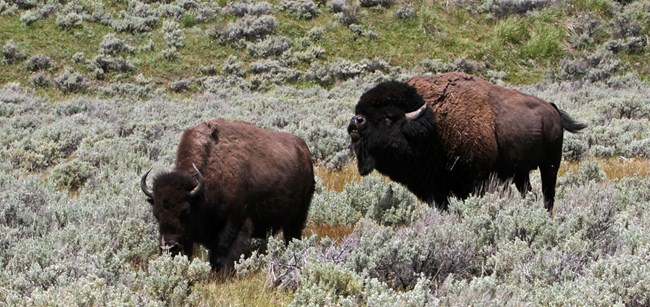
NPS / Jim Peaco DescriptionBison are the largest land-dwelling mammal in North America. Males (2,000 lbs/900 kg) are larger than females (1,000 lbs/500 kg) and both are generally dark chocolate-brown in color, with long hair on their forelegs, head, and shoulders, but short, dense hair (1 in/3 cm) on their flanks and hindquarters. Calves of the year are born after 9 to 9-½ months of gestation. They are reddish-tan at birth and begin turning brown after 2-½ months. Both sexes have relatively short horns that curve upward, with male’s averaging slightly longer than those of adult females. All bison have a protruding shoulder hump. Large shoulder and neck muscles allow bison to swing their heads from side-to-side to clear snow from foraging patches, unlike other ungulates that scrape snow away with their front feet. Bison are agile, strong swimmers, and can run 35 miles per hour (55 kph). They can jump over objects about 5 feet (1.5 m) high and have excellent hearing, vision, and sense of smell. BehaviorBison are mostly active during the day and at dusk, but may be active through the night. They are social animals that often form herds, which appear to be directed by older females. Group sizes average about 20 bison during winter, but increase in summer to an average of about 200, with a maximum of about 1,000 during the breeding season (known as the rut) in July and August. Bison are sexually mature at age two. Although female bison may breed at these younger ages, older males (>7 years) participate in most of the breeding. During the rut mature males display their dominance by bellowing, wallowing, and engaging in fights with other bulls. The winners earn the right to mate with receptive females. Once a bull has found a female who is close to estrus, he will stay by her side until she is ready to mate. Then he moves on to another female. Following courtship, mature males separate and spend the rest of the year alone or in small groups. Group sizes decrease through autumn and into winter, reaching their lowest level of the year during March and April. DietYellowstone bison feed primarily on grasses, sedges, and other grass-like plants (more than 90% of their diets) in open grassland and meadow communities throughout the year. They also eat forbs (weeds and herbaceous, broad-leafed plants) and browse (the leaves, stems, and twigs of woody plants) through the year, but those usually comprise less than 5% of the diet. They typically forage for 9 to 11 hours daily. Bison are ruminants with a multiple-chambered stomach that includes microorganisms such as bacteria and protozoa to enable them to effectively digest plant material. Bison alternate between eating and ruminating, which is regurgitating partially digested food and chewing it again, to allow microorganisms to further break down plant material into volatile fatty acids and other compounds. Their large digestive tract allows them to digest lower quality foods with greater efficiency than other ungulates such as cattle, deer, or elk. Interaction with Other WildlifeWolves and grizzly bears are the only large predators of adult bison. Dead bison provide an important source of food for scavengers and other carnivores. Bison will rub against trees, rocks, or in dirt wallows in an attempt to get rid of insect pests. Birds such as the magpie perch on a bison to feed on insects in its coat. The cowbird will also follow close behind a bison, feeding on insects disturbed by its steps.
Visit our keyboard shortcuts docs for details
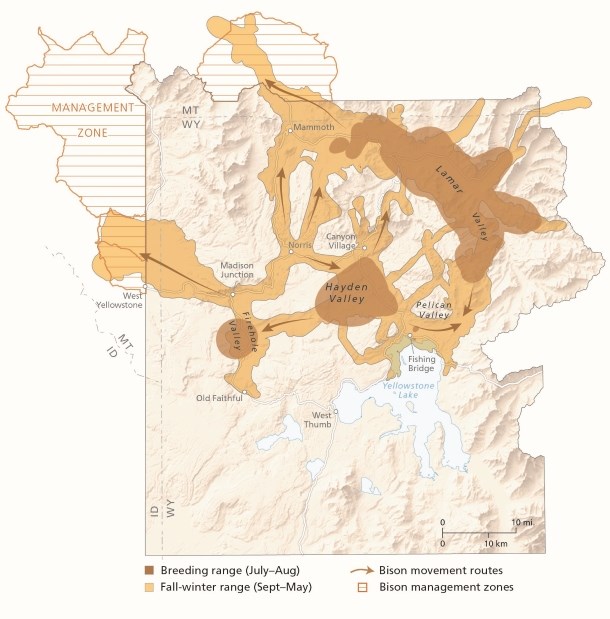
Adapted from Atlas of Yellowstone, Second Edition. ©2022 University of Oregon MigrationMost other ungulates of the Greater Yellowstone Ecosystem follow the “green wave” of sprouting plants and grasses during spring because young plants are highly nutritious. Bison begin spring by leaving winter ranges in sync with the green wave but let it pass them by as they migrate and graze, not reaching summer ranges until weeks after green-up. Bison can move out-of-sync with forage green-up because they engineer the ecosystem. Rather than just moving to find the best foods, bison create high-quality foods by how they move and graze. When bison let the green wave pass them by, they spend their time returning to graze the same areas repeatedly at high intensity. The behavior keeps plants growing, although the plants never appear more than a few inches tall, and allows bison to keep getting highly nutritious foods. In winter, bison will move from their summer ranges to lower elevation as snow accumulates and dense snowpack develops. Bison migrate up to 70 miles between summer and winter ranges. Most animals travel about 1,000 miles over the course of the year by repeatedly leaving and returning to the same areas. This means bison travel a greater distance than any other ungulate in the Greater Yellowstone Ecosystem. HabitatYellowstone bison historically occupied approximately 7,720 square miles (20,000 km2) in the headwaters of the Yellowstone and Madison rivers. Today, this range is primarily restricted to Yellowstone National Park and some adjacent areas of Montana. The bison population lives and breeds in the central and northern regions of the park. The northern breeding herd congregates in the Lamar Valley and on adjacent plateaus for the breeding season. During the remainder of the year, these bison use grasslands, wet meadows, and sage-steppe habitats in the Yellowstone River drainage, which extends 62 miles (100 km) between Cooke City and the Paradise Valley north of Gardiner, Montana. The northern range is drier and warmer than the rest of the park, and generally has shallower snow than in the interior of the park. The central breeding herd occupies the central plateau of the park, from the Pelican and Hayden valleys with a maximum elevation of 7,875 feet (2,400 m) in the east to the lower-elevation and thermally- influenced Madison headwaters area in the west. Winters are often severe, with deep snows and temperatures reaching -44°F (-42°C). This area contains a high proportion of moist meadows composed of grasses, sedges, and willows, with upland grasses in drier areas. Bison from the central herd congregate in the Hayden Valley for breeding. Most of these bison move among the Madison, Firehole, Hayden, and Pelican valleys during the rest of the year. However, increasing numbers of bison are travelling to the northern portion of the park and mixing with the northern herd. Some of these bison do not return to the Hayden Valley for the subsequent breeding season, and instead breed and rear young on their new range. The requested video is no longer available.
ConservationYellowstone has played a key role in the conservation of wild bison in North America. If fact, we've been so successful that we now face the challenge of helping to manage a rapidly growing population of migratory bison that frequently roam beyond our borders onto private land and land managed by other agencies. Read more about the history of bison management and the challenges of maintaining a wild, migratory population of bison in a modern landscape. Questions & AnswersIn North America, both “bison” and “buffalo” refer to the American bison (Bison bison). Generally, “buffalo” is used informally; “bison” is preferred for more formal or scientific purposes. Early European explorers called this animal by many names. Historians believe that the term “buffalo” grew from the French word for beef, “boeuf.” Some people insist that the term “buffalo” is incorrect because the “true” buffalo exist on other continents and are only distant relatives. On this website, we use “bison.” In recent years, the bison population in Yellowstone has ranged from 3,000 to nearly 6,000. The 2024 pre-calving (before bison calves were born in the spring) population estimate is 4,550 bison. This includes two primary breeding herds: northern and central. The northern herd breeds in the Lamar Valley and on the high plateaus around it. The central herd breeds in Hayden Valley. Bison are not listed as a threatened or endangered species. Approximately 30,000 bison live in public and private herds in North America; they are managed for conservation goals. Approximately 400,000 bison are raised as livestock however, wild bison are rare. Yellowstone bison represent the best example for preservation of wild plains bison in North America. Yellowstone is the only place in the United States where bison have lived continuously since prehistoric times. A number of Native American tribes especially revere Yellowstone’s bison as pure descendants of the vast herds that once roamed the grasslands of the United States. The largest bison population in the country on public land resides in Yellowstone. The bison is the largest land mammal in North America. Males (bulls) weigh up to 2,000 pounds (900 kg), females (cows) weigh about 1,000 pounds (500 kg). Faster than you. A bison is agile and quick, and can run up to 35 miles per hour (55 kph). A bison can also pivot quickly—an advantage when fighting predators that aim for hindquarters. A bull’s head is wider and shaped more like a triangle than the female bison; its “forehead” fur is much thicker, as is the fur on its forelegs; and its beard is thicker. A cow’s horns are slightly more curved and slender than a bull’s. In addition, a cow’s shoulders are narrower than its hips while a male’s shoulders are broader than its hips. Bison have excellent winter insulation: thick skin and underfur, long guard hairs, and layers of fat. On average, 9 out of 100 adult bison will die during the winter. Generally these animals entered winter in poor condition due to age, disease, or injuries. Young bison entering their first winter face a higher risk of dying: 20 to 40 of every 100 first-year animals may die from accidents, winter exposure, or predation. This rolling, also called wallowing, deters biting flies and removes tufts of molted fur. Bison also leave their scent in the wallow. And during the rut, bull bison wallow to display their strength and vigor. Bison eat primarily grasses and sedges and will often wander far to find habitat with appropriate food. A bison’s massive hump is comprised of muscles supported by long vertebrae; this allows a bison to use its head as a snowplow in winter, swinging side to side to sweep aside the snow. Mature bulls spend most of the year alone or with other bulls—except during the rut, or mating season. The rut begins in late July and goes through August. Bulls display their dominance by bellowing, wallowing, and fighting other bulls. Once a bull has found a female who is close to estrus, he will stay by her side until she is ready to mate. Then he moves on to another female. Bison are sexually mature at age 2. Many female bison breed at this age, but usually not males. The older males (>7 years) participate in most of the breeding. Reddish-brown calves are born in late April and May, after a gestation period of 9 to 9½ months. Calves can keep up with the herd 2 to 3 hours after birth and they are well protected by their mothers and other members of the herd. However, wolves and grizzly bears can kill bison calves. Wolves and grizzly bears can kill adult bison, but predation has little effect on the bison population. Bison usually face their attackers and defend themselves as a group, making them more difficult to kill than animals like elk that run away. The size of bison also plays a role in persuading predators to look for an easier meal. Yes, bison are migratory animals. When and where they migrate depends on a complex relationship between abundance of bison, quality and quantity of summer forage, and winter snowpack. In the Yellowstone area, they move from their summer ranges to lower winter ranges as snow accumulates and dense snowpack develops. The central herd moves both west and north toward park boundaries in winter, and may remain along the west boundary well into birthing season. The northern herd migrates within the park most winters, but will move beyond the north boundary in severe winters. Yellowstone is the only place in the United States where bison have lived continuously since prehistoric times. We know they lived here in centuries past due to fossils, oral histories from Indian tribes, and the stories of the earliest travelers to this region. Yellowstone bison historically occupied approximately 7,720 square miles (20,000 sq km) in the headwaters of the Yellowstone and Madison rivers. Today, this range is restricted to primarily Yellowstone National Park and some adjacent areas of Montana. From 30 to 60 million bison may have roamed North America before the mid-1800s. They ranged across the continent, but the majority lived on the Great Plains. Bison in the United States were hunted almost to extinction. After tribes acquired horses in the 1600s, they could travel farther to find bison and hunt the animals more easily. However, they generally did not hunt to excess. The U.S. Army held a campaign in the late 1800s to eliminate bison as a way to control tribes that depended on bison. Yellowstone was the only place in the contiguous 48 states where wild, free-ranging bison persisted into the 20th century. Ironically, the U.S. Army, which administered Yellowstone at that time, protected these few dozen bison from poaching as best they could. The Lacey Act was passed in 1894 to allow stronger punishment for poachers. Even so, Yellowstone’s bison were reduced by poaching from as many as one thousand in 1872, to approximately two dozen animals in 1902. From that small herd has grown the two large herds now occupying Yellowstone National Park. Many people consider the protection and recovery of bison in Yellowstone to be one of the great triumphs of American conservation. No. Fearing the demise of the wild herd, the U.S. Army brought 21 bison from two private herds to Yellowstone in 1902. These animals were protected and managed in Mammoth at first, and then at the Buffalo Ranch in the Lamar Valley. Meanwhile, the original herd slowly increased. In several different stages during the first half of the 20th century, the captive bison began to mix with the wild bison. The ranching operation was phased out by 1952. Source: NPS DataStore Collection 7796. To search for additional information, visit the NPS DataStore. 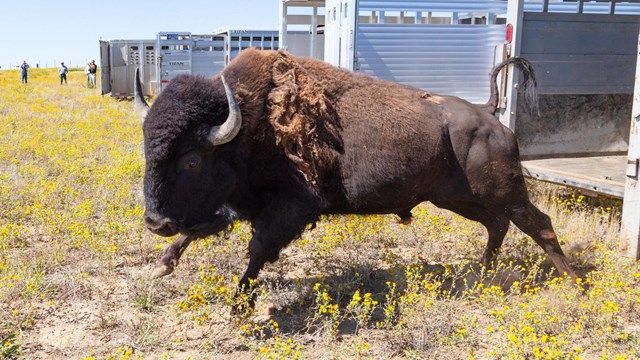
Bison Management
Learn how the park maintains a wild, migratory bison population in a modern landscape. 
History of Bison Management
Learn about the history of bison management in Yellowstone. 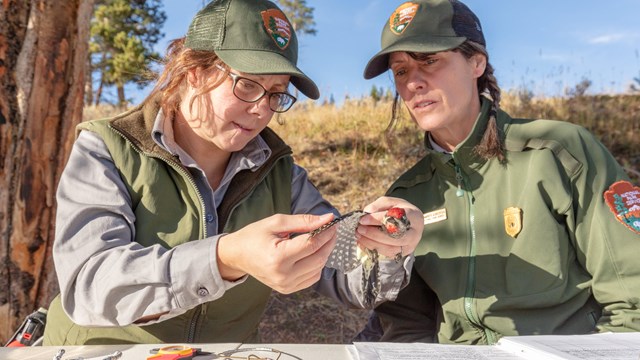
Science Publications & Reports
View science publications and reports created by Yellowstone's Center for Resources on a variety of park topics. 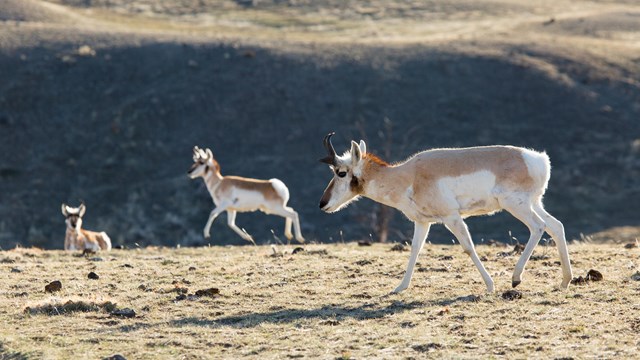
Mammals
All of the park's hoofed mammals migrate across the park to find the best plant growth. 
Wildlife Watching
Bring binoculars or a spotting scope and enjoy watching animals from a safe distance. |
Last updated: September 9, 2025
